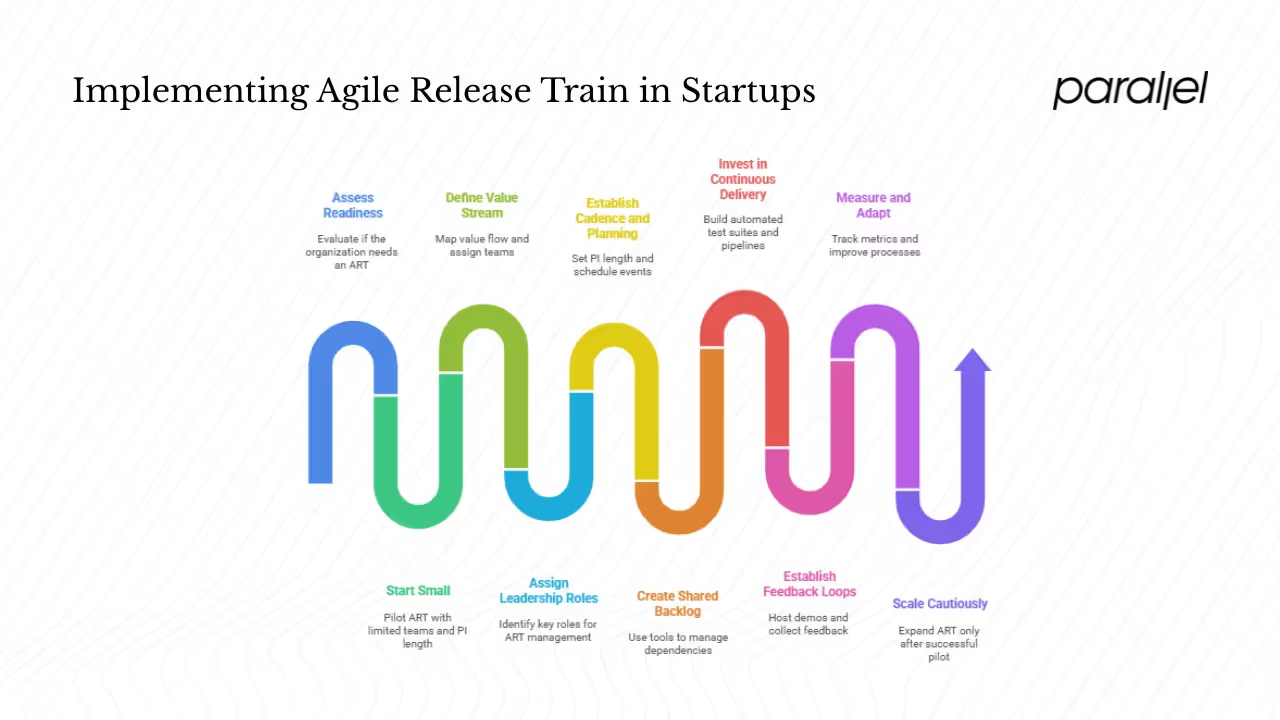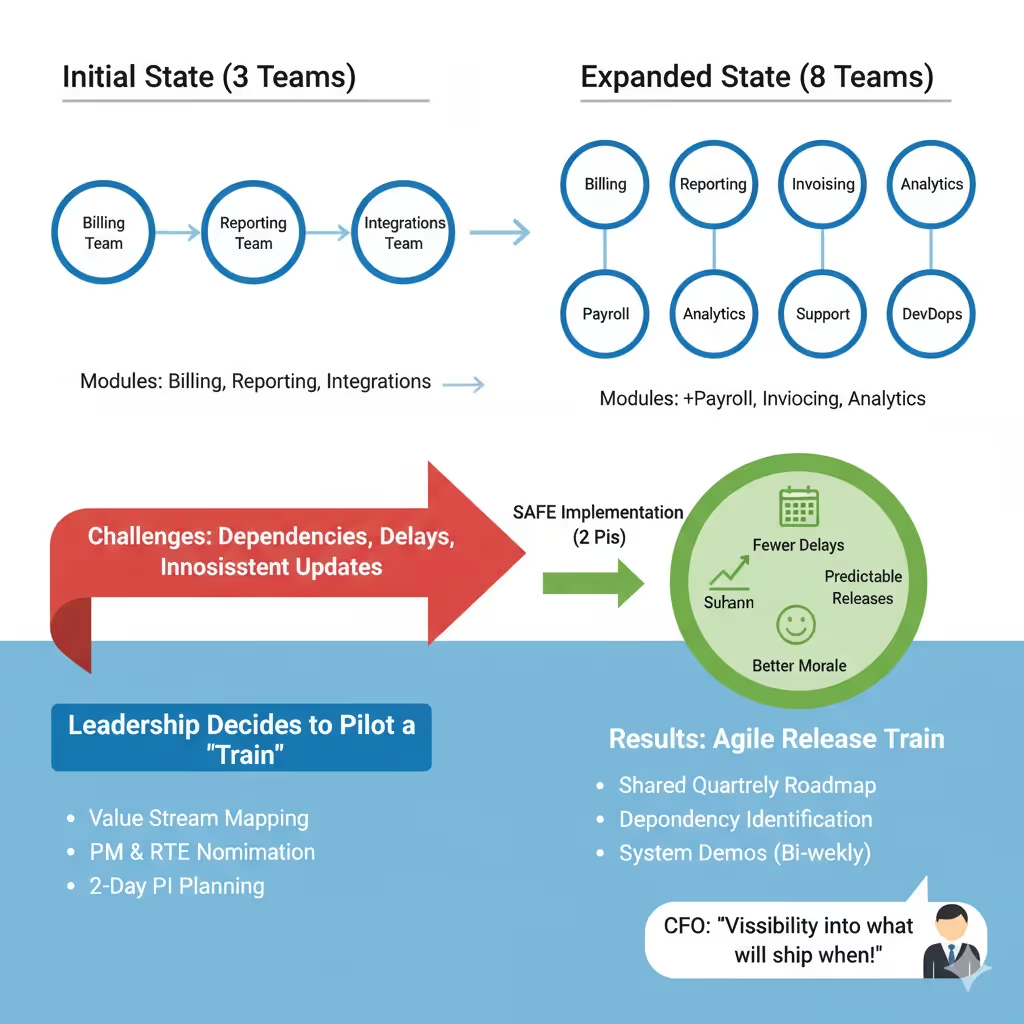What Is an Agile Release Train? Guide (2025)
Learn about agile release trains in SAFe, how they align teams and deliver value through program increments.

Growing a product from an early release to a platform with multiple modules means going from a few people in the same room to several teams working in parallel. When that happens the simple rituals that keep everyone working together start to crack: dependencies multiply, priorities drift and critical work gets lost between teams. For many organisations the Agile release train (A‑R‑T) provides structure without sacrificing agility. This piece explains what is an agile release train, how it works and when it makes sense for a startup. You’ll learn the core components of a train, the benefits and trade‑offs, how to pilot one in a young company and how to decide whether the overhead is worth it for you.
If you are asking what is an agile release train, think of it as a structured way to coordinate multiple agile teams while still embracing agile principles.
What is an Agile Release Train?
An Agile release train (A‑R‑T) is a long‑lived “team of agile teams” organised around a product or value stream. It’s not a single project but a programme that delivers a continuous stream of increments. ProductPlan, an agile planning tool, defines a train as a long‑term, dedicated cross‑functional team made up of multiple agile teams that share the vision, product backlog and roadmap defined by SAFe. Each train works to a fixed schedule and uses the same cadence for planning, development and integration.
A train typically includes five to twelve agile teams, which equates to 50 – 125 people. ProductPlan says some trains can have up to 150 people. Each member is dedicated full‑time, giving the train stability and enabling individuals to grow within the programme. Within SAFe, a train sits inside a value stream – a collection of activities that deliver value to customers. Multiple trains can be coordinated by a solution train when products are even larger.

Important features of a train include:
- Fixed schedule and cadence: The train organises work using a known schedule called a Program Increment (PI). According to ProductPlan, a PI typically lasts 12 weeks. Within that increment the train follows a two‑week system increment cadence, similar to sprints.
- Shared backlog and vision: All teams draw from the same program backlog and work toward the same product vision. Teams break work into features and stories but prioritise together.
- Synchronised increments: Teams develop on a cadence and release on demand. They build and integrate continuously but release value whenever the product is ready.
- Continuous delivery pipeline: A train invests in automation, continuous integration and testing so increments can be deployed frequently. System teams and shared services support this pipeline.
- Dedicated leadership roles: Roles like Release Train Engineer (RTE), Product Manager, System Architect and Business Owner guide the train. The RTE is similar to a scrum master at scale – they oversee execution, remove blockers and manage cross‑team dependencies.
Important components and concepts of a train
The mechanics of a train are built around recurring events and artefacts that keep dozens of people working together. Understanding these components will help you decide whether this structure suits your startup.
Program Increment (PI)
The Program Increment is the heartbeat of a train. It is a 12‑week cycle comprising multiple iterations or sprints. At the start of each PI, all teams gather for PI Planning to set objectives and plan the work. During the PI they hold train sync meetings (or scrum of scrums) to discuss progress and dependencies. At the end of the PI there is a System Demo showcasing the integrated solution and an Inspect & Adapt (I&A) workshop to reflect on what worked and what needs improvement.
Cross‑functional teams
Each agile team within a train contains all the skills needed to design, build, test and deploy features: developers, QA engineers, UX designers, product owners and business analysts. An agile team is usually ten or fewer people. The cross‑functional makeup minimises hand‑offs and eliminates the silos that slow delivery. System teams and shared services bring specialised expertise (e.g., security, database administration) into the train when needed.
Team synchronisation
Synchronisation is what differentiates a train from a loose collection of teams. SAFe prescribes regular sync meetings such as train syncs (scrum of scrums), architecture syncs, System Demos and the Inspect & Adapt workshop. These events ensure teams surface blockers early, manage dependencies and stay on the same page. Research on SAFe makes clear that the train is the mechanism used to synchronize different agile teams through joint planning, daily stand‑ups, reviews and retrospectives. Solution trains coordinate multiple trains when a product spans several value streams.
Increment planning and cadence
During PI planning, teams break down features into smaller backlog items and estimate their capacity. The PI cadence includes two‑week system increments, providing frequent integration points. Velocity within a PI is based on historical data, helping the train forecast realistically. The end of each PI includes an Innovation & Planning (IP) sprint for continuous learning, infrastructure improvements and buffer.
Continuous delivery and frequent integration
Trains strive to develop on cadence and release on demand. System teams maintain environments for development, testing and integration. Shared services provide expertise that isn’t needed full‑time. Automated pipelines and DevOps practices enable teams to deliver increments frequently while maintaining quality.
Roles and responsibilities
- Product Manager: Owns the product vision and strategy. Prioritises features across the train and ensures they match the organisation’s goals.
- Release Train Engineer (RTE): Acts like a chief scrum master for the train. Oversees execution, facilitates PI planning, removes blockers and manages risks and dependencies.
- System Architect: Responsible for the overall technical architecture across the train. Ensures that architectural decisions support current and future needs.
- Business Owner: Represents the business perspective and ensures the train’s work delivers value.
- Agile teams: Each team includes a Product Owner, Scrum Master and development team. They define, build and test features.
Events and ceremonies
- PI Planning: A two‑day event at the start of each PI where teams get on the same page about objectives and commit to delivering them.
- train sync / Scrum of Scrums: A short meeting (often weekly) where representatives from each team discuss progress and impediments.
- System Demo: Occurs every two weeks to showcase integrated work across teams. Provides feedback and ensures the solution meets acceptance criteria.
- Inspect & Adapt workshop: Held at the end of each PI to review metrics, identify problems and create improvement plans.
- Innovation & Planning sprint: A buffer at the end of the PI for exploration, hackathons and backlog refinement.
Purpose and benefits of using an Agile Release Train
Knowing what an agile release train is helps leaders appreciate why this structure matters for scaling product development.
The purpose of a train is to give multiple teams a shared structure, cadence and vision so they can deliver complex systems predictably. Important benefits include:
- Being on the same page and transparent. Shared backlog, PI planning and regular sync meetings keep all teams in sync with business priorities. In the 17th State of Agile report, 59% of practitioners report enhanced collaboration and 57% better coordination with organisational objectives%.
- Predictability and cadence. Fixed‑length PIs and known velocity create a predictable delivery rhythm. Business stakeholders know when to expect demos and releases, improving trust.
- Managed dependencies and reduced waste. Synchronised planning surfaces cross‑team dependencies early. The Release Train Engineer and System Architect coordinate to avoid duplicate work and ensure technical coherence.
- Better risk management. Frequent integration, system demos and inspect & adapt workshops enable continuous feedback and course correction. Issues are addressed before they grow.
- Enhanced quality and faster feedback loops. Continuous delivery pipelines and two‑week system increments mean defects are caught sooner. Customers or stakeholders can provide feedback earlier, helping teams build the right features.
- Scalability. When products grow outside of the capacity of one team, a train provides a scalable structure without reverting to heavy, phase‑gate project management. Research on SAFe makes clear that system and shared services teams support the train to provide environment and expertise.

Trade‑offs, challenges and when not to use a train
A train isn’t a silver bullet. Like any framework it introduces overhead and may not be suitable for all stages:
- Coordination overhead: Planning events, sync meetings and system demos require time and facilitation. Cprime’s blog makes clear that an Agile Release Train is meant to contain 50 – 125 people, typically 9 – 20 agile teams. If you have fewer than three agile teams, the overhead may exceed the benefits.
- Potential for bureaucracy: When the focus shifts from delivering value to following the process, the train can become heavy. In large programs with hundreds of people, SAFe introduces additional roles like Solution Architect and Solution Train Engineer to coordinate multiple trains. Cutting corners on these roles leads to misalignment.
- Not ideal for very small or early‑stage startups: ProductPlan acknowledges that the train framework requires a top‑down approach and is not designed for start‑ups and smaller teams. Startups often need maximum flexibility and may coordinate informally through daily stand‑ups and ad‑hoc demos.
- Cultural change required: Successful trains depend on transparency, psychological safety and shared ownership. If teams are accustomed to working in silos or resisting change, adoption will be difficult. Business teams and shared services must adopt agile mindsets.
- Tooling and automation investment: Continuous delivery pipelines, test automation and integration environments are prerequisites. Without them the train will struggle to deliver on demand.
How to implement an Agile Release Train in a startup or early‑stage setting
Before you implement it, reflect on what is an agile release train and whether your organisation truly needs that coordination layer.
For a startup approaching product/market fit with multiple squads, here’s a pragmatic way to experiment with an Agile Release Train without stifling agility:
- Assess readiness: Do you have at least three independent agile teams? Are there significant dependencies that cause delays? Is the roadmap longer than a single sprint? If the answer is yes, a train might help.
- Start small: Pilot one train covering a product or value stream. Limit the number of teams to five or six and choose a manageable PI length (e.g., eight weeks instead of twelve). Use a cross‑functional planning workshop to identify objectives and dependencies.
- Define the value stream: Map out how value flows from idea to customer. Assign teams to stages of that flow (e.g., acquisition, core product, platform). Assign a Product Manager to own the vision and backlog across teams.
- Assign leadership roles: Identify a Release Train Engineer – perhaps the most experienced scrum master – to facilitate planning, coordinate releases and coach teams. Designate a System Architect to guide technical decisions. Secure support from a Business Owner who can make priority calls.
- Establish cadence and planning: Choose a PI length that balances planning overhead and responsiveness. For example, a 10‑week PI with five two‑week iterations and a one‑week IP sprint. Schedule PI planning, system demos and retro dates up front.
- Create a shared backlog and visibility: Use a tool that can manage dependencies and display the program board. Prioritise features based on customer value and capacity across teams.
- Invest in continuous delivery practices: Build automated test suites and deployment pipelines. Encourage teams to integrate code daily. System teams can own environments and support integration and testing.
- Establish feedback loops: Host regular demos open to stakeholders. Collect customer feedback early to validate assumptions. Use inspect & adapt workshops to identify improvement actions.
- Measure and adapt: Track metrics such as velocity, predictability (planned vs. delivered work), cycle time, defect rate and team health. Businessmap’s survey shows that organisations using agile have higher project performance rates and better coordination%%. Use these metrics to assess whether the train improves outcomes.
- Scale cautiously: Only add more teams or trains when the pilot demonstrates clear benefits. Avoid running multiple trains until you have mastered one; coordinating multiple trains requires additional roles and governance.

Examples and use cases
Hypothetical startup example: Imagine a SaaS company building a platform for small business accounting. Initially there are three teams: one on billing, one on reporting and one on integrations. As the company adds payroll, invoicing and analytics modules, it expands to eight teams. Dependencies appear (e.g., changes to the invoicing API impact reporting and analytics), releases slip and customers get confused by inconsistent updates. Leadership decides to pilot a train.
They map the value stream (customer onboarding, core accounting, add‑on services), assign a Product Manager and nominate a senior scrum master as the RTE. PI planning brings all eight teams together for two days. They get on the same page about a shared quarterly roadmap, identify cross‑team dependencies and commit to objectives. System demos every two weeks surface integration issues early. After two PIs the company sees fewer delays, more predictable releases and better morale. The CFO, acting as Business Owner, appreciates the visibility into what will ship when.

Real‑world case snippet: Cprime’s guidance makes clear that trains are intended for 9 to 20 agile teams (approximately 50 – 125 people). They caution that smaller groups may not gain enough value from the structure, and larger programmes require investing in higher‑tier roles like Solution Architect and Solution Train Engineer. ProductPlan emphasises that while a train improves cross‑functional collaboration and transparency, it introduces a top‑down structure that isn’t suited to startups. Use these insights to decide whether your company has reached the tipping point where coordination costs exceed the overhead.

Conclusion
Asking what is an agile release train at the right moment can save your teams from unnecessary complexity.
Scaling a startup is exciting and messy. When you have one or two teams you can keep everyone working together through informal conversations and a shared backlog. As you add more teams, misalignment and delays creep in. That’s when you should ask what an agile release train is and whether it can help. A train offers a proven structure for bringing multiple teams together around a shared vision, cadence and backlog. It introduces predictable planning cycles, synchronises releases and improves transparency. At the same time, it requires investment in facilitation, automation and cultural change.
In my experience working with early‑stage SaaS companies, the tipping point often comes when there are five or more teams working on related components. Before adopting a train, assess whether your problems stem from coordination or from unclear strategy. If the former, start with a pilot train, keep it lightweight and adapt the cadence to your context. Don’t be afraid to adapt the framework – the goal is to empower people to deliver value together, not to implement a textbook process.
If you’re a founder or product leader feeling the pain of misaligned teams, consider running a discovery workshop to map your value stream and dependencies. That activity alone can reveal whether you need an Agile Release Train or simply better communication. Either way, the principles behind the train – shared vision, synchronised cadence and continuous feedback – can help you build products that matter.
FAQ
1) What is the purpose of an Agile Release Train?
The purpose of an Agile Release Train is to synchronise multiple agile teams around a common vision, cadence and backlog so they can deliver complex products predictably. The train provides a way for teams to get on the same page, be transparent and share a schedule. It improves collaboration and reduces inter‑team friction by making dependencies visible and coordinating joint planning%. Continuous delivery pipelines and regular system demos accelerate feedback and improve quality.
2) What is the difference between a sprint and a release train in agile?
A sprint is a short iteration (usually one or two weeks) during which an agile team delivers a potentially shippable increment. The scope is limited to a single team. A release train, on the other hand, is a long‑lived programme that coordinates multiple teams. It works on a fixed Program Increment schedule (often 8–12 weeks) and synchronises sprints across teams. All teams share a common backlog and vision and release to customers in a coordinated fashion.
3) What is the difference between an Agile Release Train and a scrum team?
A scrum team is a small, cross‑functional group (typically up to ten people) that owns its backlog and delivers value in sprints. An Agile Release Train is a “team of teams” composed of five to twelve scrum or kanban teams, totalling roughly 50 – 125 people. While a scrum team has a Scrum Master and Product Owner, a train adds roles such as Release Train Engineer, Product Manager, System Architect and Business Owner to coordinate work across teams. Events like PI planning, System Demo and Inspect & Adapt extend the scrum ceremonies to the programme tier.
4) What is an example of an Agile release train event?
The Program Increment (PI) Planning event is the cornerstone ceremony of a train. It is a two‑day face‑to‑face (or virtual) workshop at the start of every PI. All teams, product management, business owners and stakeholders attend. They review the product vision, set PI objectives, plan features across iterations and identify dependencies and risks. By the end of PI planning each team has a plan and the train has a set of committed objectives. Other important events include the System Demo (a live demo of integrated work every two weeks) and the Inspect & Adapt workshop (a structured retrospective and problem‑solving session at the end of the PI).



.avif)









